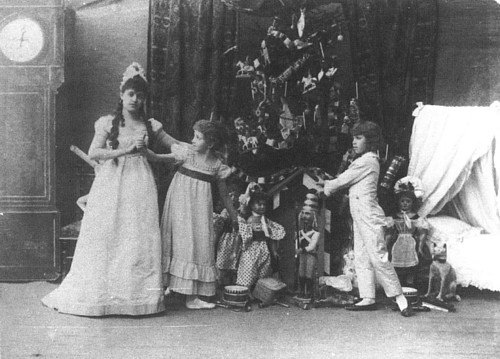How “The Nutcracker” Became a Holiday Tradition

Original production of The Nutcracker (Imperial Mariinsky Theatre, Saint Petersburg, 1892)
The Nutcracker—it’s as synonymous with the holiday season as twinkling lights, candy canes, and fir trees. Pyotr Ilyich Tchaikovsky’s 1892 ballet is performed by virtually every ballet company during the month of December. But it may surprise you to learn that it wasn’t always a holiday staple. In this article, we’ll take a look at the history behind The Nutcracker to see how it came to be the cherished Christmas tradition we know it as today.
The history of The Nutcracker dates back to 1816 when author E. T. A. Hoffmann penned Nussknacker und Mausekönig (or The Nutcracker and the Mouse King). Hoffmann’s short story, which takes place on Christmas Eve, is a dark fairy tale for adults, complete with bloody battles between toy soldiers and a seven-headed mouse king, as well as a creepy godfather, scary hallucinations, and strict parents.
In 1845, French writer Alexandre Dumas published a retelling of Hoffmann’s story called Histoire d'un casse-noisette (or The Tale of the Nutcracker). Dumas, of The Three Musketeers fame, made Hoffmann’s dark flights of imagination sweeter and tamer, turning Hoffmann’s social critique into an entertaining story fit for children.
Fast forward to 1891. After the success of Tchaikovsky’s 1889 ballet The Sleeping Beauty, Director of the Imperial Theaters Ivan Vsevolozhsky commissioned Tchaikovsky to compose another ballet, this time based on Dumas’ version of Hoffmann’s Nutcracker story. The ballet would premiere as the second half of a double bill alongside Tchaikovsky’s one-act opera, Iolanta.
For the ballet, Tchaikovsky reunited with his choreographer from The Sleeping Beauty, Marius Petipa. Petipa made further changes to Dumas’ version of Hoffmann’s story to make it more appropriate for the ballet stage, such as adding the role of the Sugar Plum Fairy. Tchaikovsky initially had misgivings about the scenario and resented Petipa’s highly detailed and specific instructions for what music Tchaikovsky was to compose for each scene. Nevertheless, he overcame these reservations and went on to pen one of the most beloved ballet scores of all time.
Unfortunately, Petipa fell ill in August 1892 and had to pull out of the production. His long-time assistant, Lev Ivanov, took over. The lack of creative cohesion and Ivanov’s differing approach to choreography contributed to the ballet’s ultimate failure when it premiered on December 18, 1892, at the Imperial Mariinsky Theatre in Saint Petersburg. Critics complained about the sudden leap from reality in the first act to the imaginary Land of Sweets in the second. Some also decried the centering of children in the ballet over adult principals. As one critic scathingly wrote, “For the woman dancer there is very little in it, for the art precisely nothing, and for the artistic fate of our ballet—it is yet one more step downwards.”
That said, no one could fault Tchaikovsky’s score, so rich in memorable melodies and orchestral colors. While it is so familiar to our ears now, The Nutcracker introduced audiences to a brand-new instrument from France called the celesta, which sprinkles a magical layer of fairy dust over the famous “Dance of the Sugar Plum Fairy.” Tchaikovsky first heard the instrument, invented by organbuilder Auguste Mustel in 1886, while in Paris in 1891. He wrote to his publisher directly, asking that they acquire one before another Russian composer could beat him to the punch.
Nine months before the premiere of The Nutcracker, Tchaikovsky had excerpted a concert suite of eight movements from the full ballet score. The Nutcracker Suite found immediate success and quickly entered the orchestral repertoire, while the ballet was rarely staged. Tchaikovsky died in November 1893, never getting to witness the global success his ballet would one day become.
The first full performance of The Nutcracker outside of Russia was mounted by the Sadler’s Wells Ballet in London in January 1934. In 1940, Walt Disney included The Nutcracker Suite in his classical music film Fantasia, introducing a wide market of listeners—particularly children—to the magical music of Tchaikovsky. Finally, The Nutcracker had its full US premiere in San Francisco on Christmas Eve, 1944—an extraordinary feat given wartime rations on fabric and the production's shoe-string budget of just $1,000.
The Nutcracker continued to gain traction with George Balanchine’s iconic production for the New York City Ballet in 1954. Balanchine had fond memories of dancing in The Nutcracker as a teenager in Russia and wanted to introduce American audiences to the ballet. Balanchine’s choreography and staging, which features children throughout, is now considered the quintessential version of the ballet, influencing the majority of productions to this day.
Television broadcasts of Balanchine’s production in the late 1950s furthered Americans’ interest in The Nutcracker. By the 1960s, The Nutcracker had become a holiday staple on a par with Handel’s Messiah and Dickens’s A Christmas Carol. According to the National Endowment for the Arts, productions of The Nutcracker typically account for an average of 48% of a ballet company’s revenue each season, generating $51 million in ticket sales nationwide. In 2011, the NEA estimated there were over 750 different productions of The Nutcracker across the United States alone.
In central Illinois, there are at least two productions of The Nutcracker you can attend: December 4–7, Champaign-Urbana Ballet presents The Nutcracker at the Krannert Center for the Performing Arts, while on December 7, the Danville Symphony Orchestra performs The Nutcracker with Von Heidecke’s Chicago Festival Ballet.



